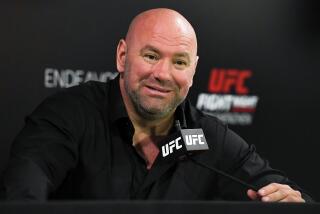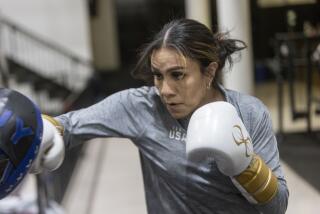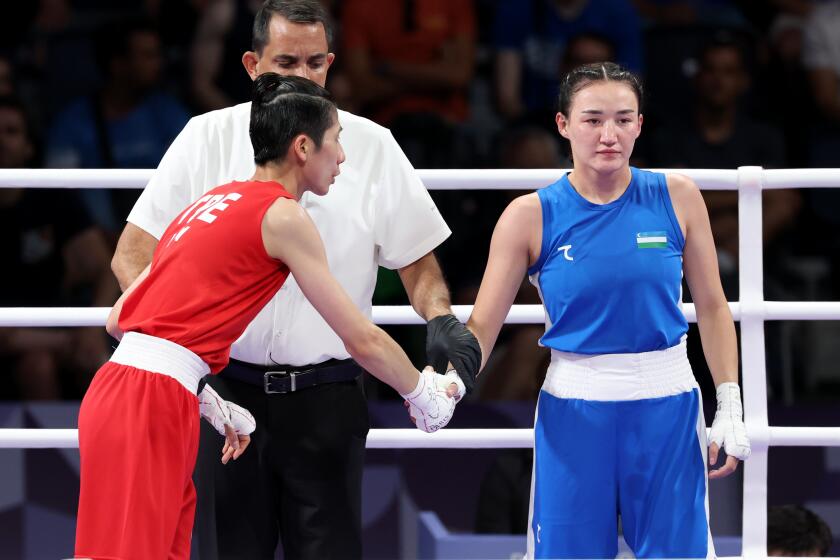Head of the Class : Michael Carbajal Will Become First 1988 U.S. Olympian to Fight for a World Title Today
PHOENIX — Michael Carbajal, who today becomes the first 1988 U.S. Olympic team boxer to fight for a world pro championship, was talking about his old neighborhood.
Carbajal’s neighborhood, 10 minutes from the gleaming office towers of downtown Phoenix, is an area of boarded-up homes, broken bottles and beer cans in the streets, and wrecked cars parked on weed-filled front yards.
Carbajal, 22, grew up here. Now he is successful and makes lots of money.
Scottsdale here we come, right? No. He is staying.
Carbajal is a very unusual athlete. You get no glitz, no jewelry, no flashy cars, no gated estate. You don’t even get an entourage of moochers. There is only Carbajal and his brother, Danny, and sometimes Michael’s lawyer, Ben Miranda, an old school chum of Danny’s.
With Carbajal, you get something that seems somewhat out-of-place in American pro sports--values rooted in home and family.
Carbajal, a 5-foot-5 1/2, 108-pounder, will make $75,000 when he fights Thailand’s International Boxing Federation light-flyweight champion, Muangchai Kittikasem, today in Phoenix’s Veterans Memorial Coliseum. Yet Carbajal still lives with his parents, brothers, sisters and numerous nieces and nephews in a crowded, dilapidated but very happy home on East Fillmore Street.
So he seemed startled recently when a reporter asked him when he planned to move.
“Why would I do that?” he asked. “This is my home. I’ve always lived here. Maybe some day I’ll buy my mom and dad a place of their own. But even if they move out, I’ll stay here.”
Mind you, here’s a guy who’s earning more money than any U.S. flyweight ever. His $75,000 purse is his biggest yet, but he has had two $50,000 purses. He has a network TV deal.
And should he win the IBF title today, and should his promoter, Bob Arum, secure a light-flyweight showdown with Mexico’s World Boxing Council champion, Humberto Gonzales, Carbajal’s purse would advance well into six figures.
Arum said a year ago that his goal with Carbajal was to maneuver him into history’s first $1-million light-flyweight fight.
But even if that happens, don’t look for any Italian sports cars parked in front of Carbajal’s house or gold chains around the fighter’s neck.
When Carbajal needed a car eight months ago, he bought a ’62 Chevrolet Impala. A couple of weeks ago, he signed on as a spokesman for a Phoenix Oldsmobile dealer, who presented him with a new Olds.
“It’s nice, I’m driving it around,” Carbajal said. “But the Impala is still my favorite. It’s in the shop now, getting all new wiring.”
Not long ago, a reporter showed up at the Carbajal compound (Michael’s older brother/manager/trainer, Danny, lives next door, in a house built in 1910) for an interview.
The reporter found Michael on the front porch, seated on a rubber ice chest, a towel wrapped around his shoulders while Danny gave him a haircut. Danny was a barber until the mid-1980s, when he realized that his scrawny little brother could fight.
Success hasn’t gone to Danny’s head, either. The vehicle parked on his front lawn is a 1979 Jeep.
Are the Carbajals frugal or simply cheap?
“Let’s put it this way,” one Phoenix boxing observer said, “Danny and Michael aren’t what you would call big tippers.”
So, what’s happening to all the money?
“We’re thinking of building a gym for the kids in our neighborhood,” Michael said. “Danny and I have some land picked out, on 9th Street, so we’re making plans.”
Michael Carbajal is one of the more intriguing stories of the 1988 U.S. Olympic boxing team. Much was made of his learning to box in a tiny ring Danny had built for him in an old shed behind his house.
The reporter asked to see the ring. Moments before reaching the shed, Danny said: “Watch out for the pits.”
At that, two pit bulls, chained to a tree, leaped from behind bushes, falling just short of the visitor.
“We keep them out here to guard the place,” Danny Carbajal said.
If Michael Carbajal becomes a champion today, his ring should be shipped to a boxing museum. It is 10 feet on a side. The roof is barely six feet high, and is held together by plywood patches, corrugated steel sheeting and two-by-fours. Faded posters of Roberto Duran and Carlos Palomino adorn the walls.
“This is one reason why Michael is such a good fighter on the inside today,” Danny said. “There’s not much room to run around in here, you’re forced to spar at close quarters. And the little ring made him fight well laterally, too.”
In other words, Carbajal never learned how to back up. There was no room.
How hot does the shed become?
“We don’t know,” Danny said. “The temperature gauge only goes up to 120.”
Carbajal, boxing in the same weight class in which East Los Angeles’ Paul Gonzales won a gold medal at the 1984 Olympics, nearly won the gold in Seoul in 1988. But in what many considered the most unfair decision to that point in the Olympic tournament, he lost a decision to Ivailo Hristov of Bulgaria.
“I think a lot of people would still remember what a bad decision that was, except later that day Roy Jones (the U.S. light-middleweight) got robbed on a decision that was even worse,” Danny Carbajal said.
The Carbajals took the disappointment in typical Carbajal fashion. There were no tantrums, no howls of outrage, no tears. They let the U.S. boxing officials do all the protesting. Poked and prodded for comment by reporters in the interview room afterward that day, the quiet little fighter would only mumble: “It just wasn’t meant to be, I guess.”
In fact, only a frown by the poker-faced Carbajal at the announcement of the winner betrayed his feeling at earning the silver medal instead of the gold.
At the Olympic team’s pre-Seoul training camp, Carbajal was the coaches’ favorite.
“He was great in camp,” said Tom Coulter, one of the coaches. “He was the hardest worker on the team. He showed great discipline, great work habits. He worked very hard and never had anything to say. He won every sprint, every distance run. No one could stay with him on the road. He ran one 5:15 mile after another.
“In fact, his road work was so good I told him I thought he could get a cross-country or track scholarship someplace.”
Carbajal turned pro shortly after the Games and, with a 14-0 record, has remained one of the busiest graduates of the 1988 Olympic team.
Humberto Gonzalez’s promoter claims Carbajal is ducking his fighter.
“I’ve called Bob Arum and talked about a Gonzalez-Carbajal fight, and all he ever says is, ‘Send me a video,’ ” Rafael Mendoza said.
“That’s nonsense. He knows perfectly well what a great fighter Gonzalez is, and he knows Carbajal isn’t in Humberto’s class.”
The Carbajals, of course, laugh all this off. After only two years in the pro game, they know a thing or two about promotion buildups. Both concede Gonzalez, who has 23 knockouts in his 28-0 record, is a formidable fighter.
“They can talk trash as long as they want,” Danny Carbajal said. “If Gonzalez is as good as they think he is, then why should we fight now? Let’s let the fight develop. Why don’t they go take the Korean’s (Woo Yuh Myung of South Korea, the World Boxing Assn. champion) title? Then our fight with Gonzalez could be a unification fight.
“The reason why they want the fight now is because they know Michael is improving rapidly, and they know Gonzalez would have no chance a year or more from now.”
Carbajal is exceptionally tall for a light-flyweight, and has a long reach. He uses his height to great advantage, with a busy, accurate jab. Inside, he is an effective, aggressive body puncher. He has stopped eight of his 14 opponents, and several of them have been clean knockouts.
His opponent today is a former kick boxer who has defended his IBF title four times, yet has only a 10-0 record. And Kittikasem, until today, has never fought outside Bangkok.
For the past week, both Carbajal and Kittikasem have trained at the La Mancha Athletic Club and Hotel in downtown Phoenix, where the Thai champion, except for his workouts, has remained in seclusion.
He arrived in Phoenix July 20 with a traveling party of 14. Jay Edson, Arum’s event coordinator, said the first question asked of him when he met the Thais at the airport was if Kittikasem could be paid his $150,000 purse up front, in cash. No, the Thais were told.
“The next thing they wanted to know was could they could set up security in the hotel kitchen, to prevent being poisoned,” Edson said.
Not to worry, Edson told them. Finally, an arrangement was made with a nearby Thai restaurant, Thai Rama, to deliver the champion’s meals three times a day.
“This kid (Kittikasem) is just like (Marvin) Hagler before a fight,” Edson says. “He locks himself up in his room and stays there. No one sees him. I guarantee you he hasn’t been in the coffee shop once.”
Kittikasem has fought only Asian opponents and brought only Thai sparring partners with him to Phoenix. For those reasons, one Las Vegas sports book made Carbajal a 3-1 favorite.
Carbajal was supposed to have had this fight May 13 in Atlantic City. But Kittikasem suffered a broken knuckle in training three weeks before the fight, forcing a postponement.
Carbajal, who says his “walking around” weight between fights is 110 to 112 pounds, has no trouble making 108. In fact, after the Olympics, Carbajal debated briefly whether or not to turn pro at strawweight, a division peopled almost entirely by Asian and Hispanic boxers and for which the weight limit is 105 pounds.
For brother Danny, who at 39 packs an ample midriff, the toughest part of managing his brother’s career is watching him eat.
“It makes me want to cry,” he said. “He eats anything he wants, even in training, and never puts on an ounce.”
More to Read
Go beyond the scoreboard
Get the latest on L.A.'s teams in the daily Sports Report newsletter.
You may occasionally receive promotional content from the Los Angeles Times.










